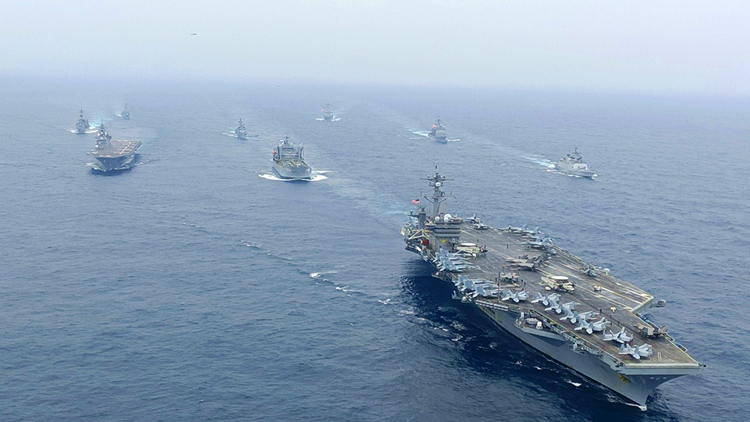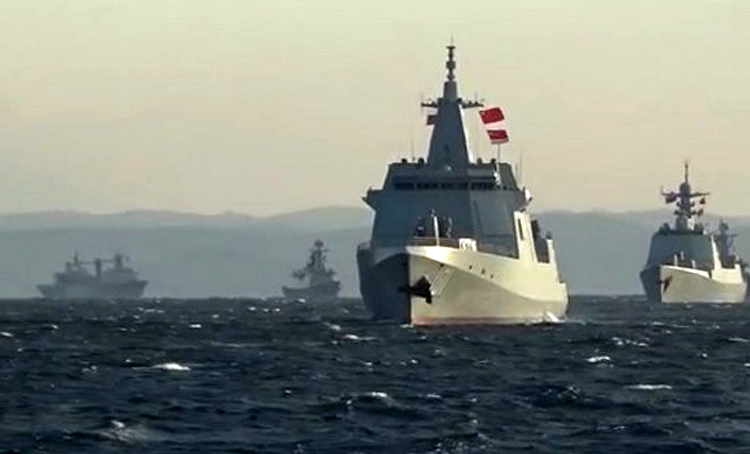INDIAN ARMED FORCES CHIEFS ON OUR RELENTLESS AND FOCUSED PUBLISHING EFFORTS

The insightful articles, inspiring narrations and analytical perspectives presented by the Editorial Team, establish an alluring connect with the reader. My compliments and best wishes to SP Guide Publications.

"Over the past 60 years, the growth of SP Guide Publications has mirrored the rising stature of Indian Navy. Its well-researched and informative magazines on Defence and Aerospace sector have served to shape an educated opinion of our military personnel, policy makers and the public alike. I wish SP's Publication team continued success, fair winds and following seas in all future endeavour!"

Since, its inception in 1964, SP Guide Publications has consistently demonstrated commitment to high-quality journalism in the aerospace and defence sectors, earning a well-deserved reputation as Asia's largest media house in this domain. I wish SP Guide Publications continued success in its pursuit of excellence.
- Operation Sindoor: Resolute yet Restrained
- India’s Operation Sindoor Sends a Clear Message to Terror and the World – ‘ZERO TOLERANCE’
- Japan and India set forth a defence cooperation consultancy framework, talks on tank and jet engines
- Terrorist Attack in Pahalgam in Kashmir: Unfolding a long surgical war against PAK
- Lt General Pratik Sharma takes over Command of Indian Army's Northern Command
Second Phase Malabar 2021
The second phase of Malabar 2021 exercise is reflective of the commitment of the participating countries to support a free, open, inclusive Indo-Pacific as well as a rules-based international order
 |
The Author is Former Director General of Information Systems and A Special Forces Veteran, Indian Army |

India, the United States, Japan and Australia kicked off the second phase of this year’s Malabar naval drills in the Bay of Bengal on October 12. The exercise aimed to build on the synergy, coordination and interoperability developed during the first phase held in August 2021, the Indian Navy said in a statement, adding that the second phase, held from October 12-15, focussed on advanced surface and anti-submarine warfare exercises, seamanship evolution and weapon firings. The 25th edition of Malabar exercises is being conducted in two phases, while observing all protocols during the COVID-19 pandemic.
The first phase of Malabar 2021 by the QUAD navies was conducted from August 26 to 29 near Guam in the Pacific Ocean involving destroyers, frigates, corvettes, submarines, helicopters, long-range maritime patrol aircraft, US Navy SEALs and Indian Navy’s MARCOS. Between the two phases of Malabar 2021, India also conducted bilateral naval exercises both Australia and Japan to boost interoperability further.
The second phase, held from October 12-15, focussed on advanced surface and anti-submarine warfare exercises, seamanship evolution and weapon firings
In the second phase of Malabar 2021, India Navy’s participation included INS ‘Ranvijay’, INS ‘Satpura’, P-8I long range maritime patrol aircraft and a submarine. The US Navy (USN) was represented by nuclear-powered aircraft carrier USS ‘Carl Vinson’ and two destroyers - USS ‘Lake Champlain’ and USS ‘Stockdale’. The Japan Maritime Self Defence Force (JMSDF) was represented by J.S. ‘Kaga’ and J.S. ‘Murasame’, while the Royal Australian Navy (RAN) was represented by HMAS ‘Ballarat’ and HMAS ‘Sirius’. According to Commander Vivek Madhwal, spokesperson of Indian Navy, the second phase of Malabar 2021 exercise is reflective of the commitment of the participating countries to support a free, open, inclusive Indo-Pacific as well as a rules-based international order.
The Malabar series of exercises began as an annual bilateral naval exercise between India and the US in 1992. During Malabar 2007, the US Navy had the largest representation with 13 warships including the nuclear-powered aircraft carrier USS ‘Nimitz’. In 2015, JMSDF joined Malabar as a permanent member. The 2020 edition of Malabar witnessed participation of the RAN a second time, after a long gap.
Over the years, Malabar exercises have practiced diverse activities ranging from fighter combat operations from aircraft carriers through maritime interdiction operations, anti-submarine warfare, diving salvage operations, amphibious operations, counter-piracy operations, replenishment-at-sea, cross–deck helicopter landings and anti–air warfare operations.
China has been wary of the Malabar exercises and more about the QUAD
China has been wary of the Malabar exercises and more about the Quad. In June 2007, China issued a ‘demarche’ (sic) to India, the US, Japan and Australia seeking details about their four-nation meeting, termed a Quadrilateral Initiative – cheek of Beijing, while China itself had been conducting naval exercises with other countries including Bangladesh and Myanmar. However, India and Australia assured Beijing that security and defence issues did not form part of the meeting's agenda.



Reacting to the first virtual QUAD Leaders Summit in March 2021, China’s foreign ministry spokesperson Zhao Lijian said no "small cliques" should be formed, and accused some countries of trying to "sow discord" among regional nations by "hyping" the "China threat"; even as the QUAD Leaders had announced that a "free and open" Indo-Pacific is essential to their countries, and vowed that they were committed to achieve stability.
Without mentioning the US, Lijian also said, "Certain countries should shake off their Cold War mentality and ideological prejudice, refrain from forming closed and exclusive small circles, and do more things that are conducive to solidarity and cooperation among regional countries and regional peace and stability."
China went ballistic even more over establishment of the AUKUS saying that the creation of the AUKUS trilateral alliance between the United States, Britain and Australia aims to stir up the Cold War
Ahead of the first in-person QUAD Leaders Summit at the White House in September 2021, China again criticised the grouping with China’s foreign ministry spokesperson Zhao Lijian stating during a media briefing, “China always believes that any regional cooperation mechanism should not target a third party or harm its interests. Seeking exclusive closed cliques against a third country runs against the trend of the times and aspirations of countries in the region. It will find no support. The growth of China means the growth for peace and stability in the world (sic) and China’s contribution to peace, stability and development in Asia Pacific is therefor all to see. Relevant countries should do more that is conducive to solidarity and cooperation with the four countries in the region.”
China went ballistic even more over establishment of the AUKUS. China’s Deputy Foreign Minister Le Yucheng stated in an interview with CGTN TV channel recently that the creation of the AUKUS trilateral alliance between the United States, Britain and Australia aims to stir up the Cold War, violate the provisions of the Non-Proliferation Treaty and threaten a nuclear catastrophe in the Pacific.

Beijing has militarised man-made islands in Western Pacific due to American intransigence, mostly during the 10 years of the Obama administration, and is engaged in hotly contested territorial disputes in the South and East China Seas. Beijing claims sovereignty over all of the South China Sea but Vietnam, Malaysia, the Philippines, Brunei and Taiwan have counterclaims. In the East China Sea, China has territorial disputes with Japan. Both maritime areas in the South and East China seas are rich in minerals, oil and other natural resources and are also vital to global trade.
China is well aware that the QUAD and AUKUS have come up because of its aggressive behaviour and increasing military muscle-flexing in the Indo-Pacific region. But it would not see any immediate threat from AUKUS knowing it would take a decade and a half or so for Australia to acquire the six nuclear-powered submarines. Besides, Beijing would be happy about the conciliatory note in US President Joe Biden’s recent speech at UNGA. That is why China has become more belligerent against India and Taiwan.
China is well aware that the QUAD and AUKUS have come up because of its aggressive behaviour and increasing military muscle-flexing in the Indo-Pacific region
The ongoing Russia-China naval exercise ‘Maritime Interaction 2021’ in the Sea of Japan will last till October 17. Russian Navy participation is of warships and support vessels of the Pacific Fleet, including the anti-submarine ship ‘Admiral Panteleev, corvettes of the project 20380 ‘Hero of the Russian Federation Aldar Tsydenzhapov and ‘Gromkiy, two base minesweepers, the submarine of project 877 Ust-Bolsheretsk, a missile boat and a rescue tug. Both navies are practicing joint tactical maneuvering, mine countermeasures, artillery firing at sea, search and block mock enemy submarine.
Since India is in a protracted hostile border with China and ongoing sub-conventional war with China-Pakistan, in addition to possibility of conflict, QUAD and AUKUS will remain of peripheral consequence for the time being. However, concurrent to the second phase of Malabar 2021 kicking off on October 12, Admiral Michael Gilday, Chief of US Naval Operations has stated that the cyber domain is one area that the Quad navies would continue to refine in terms of working together as well as high-end operations in the air, on the sea and under the sea. He also said that the scope of the multi-nation Malabar exercise in terms of more like-minded navies taking part in the drills could expand in future and that it was for the Quad partners to discuss the possibility of an expansion.





